We’ve run into many challenges this year with no-till planting research plots, difficulties that are likely mirrored on farms throughout our region. Clean-till (Conventional-till) practices allow farmers to plant into an ideal seedbed for prime seed-to-soil contact – fine-textured, well-packed, yet yielding to the smallest seeds.
No-till management is often trickier, but once you can achieve a good stand, offers many advantages. Soil maintains better structure and integrity. Runoff from no-till ground with continuous cover is usually clear, carrying little topsoil with it. Organic matter and soil life are better preserved, which means heightened soil health and resilience. We see firsthand evidence all the time that soil with a continuous cover stays softer, while exposed, fallow ground dries out, hardens, or erodes, depending on conditions and soil type. The soils we observe have a high clay content and therefore harden and dry out quite easily when exposed. But the surface layer of residue that helps protect the value beneath it can also make planting a battle. It’s a balancing act, and while no-till may or may not be right for your soil and operation, keeping the ground covered throughout the year – with residue or living cover – is usually a best practice.
Our Lancaster County, PA-based farm collaborator, where we have many research plots, practices continuous no-till management. He has done so for 13 years. This means that a crop is often planted into a killed, mowed, or harvested preceding crop. We just finished planting most of our summer annual plots into winter annual small grain stubble – barley, rye, wheat, triticale, and, perhaps most notably, the annual ryegrass stubble that grew along with the triticale and wheat in our “Wheat Plus” and “Triticale Plus” mixes. Stubble often needs a few weeks to break down after the forage has been harvested and sprayed. These crops produce very dense root mass and above-ground stubble that is powerful obstacle to the no-till drill, even one with lots of weight on it.

The weights on the front of the drill are called suitcase weights. Each one of these weighs 80 lbs. so we have 5 mounted on each side, (10 x 80 = 800lbs) But the weights alone were not enough for the drill to cut down into the Hagerstown silt loam soil that we were planting into when it was dry – we still could not get the seed sufficiently deep enough down into the soil for adequate seed to soil contact and depth placement.
We then added feed bags that weigh 100 lbs each. We added four to the front, about 400 more lbs, and 5 to the back, 500 more pounds. This means we needed 1,700 lbs of ballast to be able to get the proper depth. At one point we were at 2000 lbs. One of the tires with a crack already in it blew, then we blew a hydraulic line in attempts to maximize the weight on the drill.
No-till drilling summer annuals in the dry summer can be quite a different animal than drilling in the moist soils of spring or in late summer/fall.
Adding several hundred pounds of weight to the drill can make a huge difference in its ability to cut through the top layer of residue. Annual ryegrass stubble was our toughest opponent, however. It is pretty deceiving, with its fine stems and succulent aboveground growth, not even fibrous enough to make dry hay. Added to this, our fall October 2012-planted crop had been mulched, leaving 4-6 inch long fragments of residue on the surface. As we discovered, this caused unexpected “hairpinning” as we tried to drill sorghum-sudangrass – the short pieces of ryegrass residue got caught across the coulters’ path and bent into the furrow, where they prevented seed-to-soil contact. Where the coulters hit the spots where the previous rows had been, they had a tough time cutting through the thick, bristly stubble and dense root mass beneath. Indeed, after the sorghum-sudangrass began to emerge, the longest skips showed up where the openers had traveled over these preexisting rows and failed to pry apart the stubble.
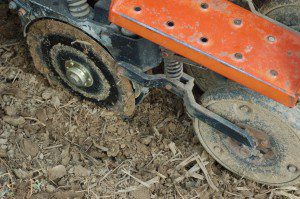
In no-till circumstances, ryegrass stubble that has grown into May for a forage harvest seems to need close to a month to break down before another crop can be easily planted into it. However, ryegrass grown as a cover crop alone is typically killed at a shorter (younger) stage and earlier in April. The good news about ryegrass is its productivity, organic matter contribution, high forage quality, low cost, and weed suppression (both from the crop and the residue).
We ran into similar challenges with an early May planting of no-till corn. In part of the field the corn had been planted into a killed (but not mulched) crop of Wheat Plus (a blend of wheat and annual ryegrass). With a few varieties, emergence was poorer (we had to fill in in places with hand-jabbing), but weed suppression was excellent. Almost no weeds grew here to compete with the corn, whereas areas of thicker but less consistent residue (like last years’ sorghum) show a weed flush. The glyphosate-killed Wheat-plus formed a thick surface mat that did not hairpin as much since it was still rooted. (Smaller, loose pieces of trash seem to get bent and pinned into furrows much more easily.)
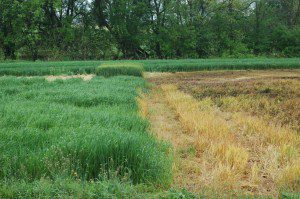
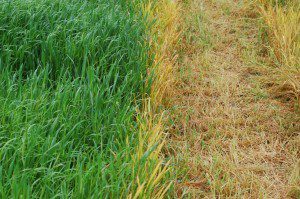
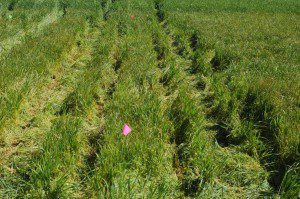
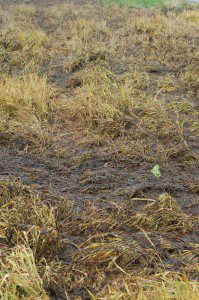
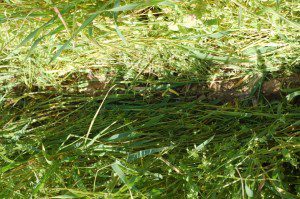
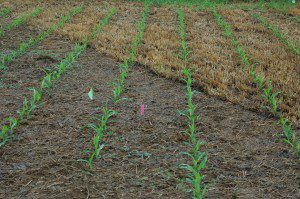
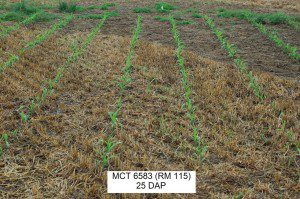

Speak to an expert at King’s AgriSeeds now at 1-717-687-6224 or email us at [email protected].

